DISCOVER THE FASCINATING MEDIEVAL CITY OF TROYES
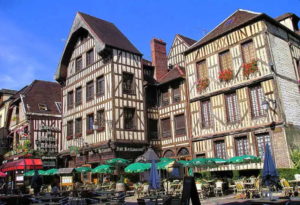
Troyes is one of the most alluring and interesting medieval towns in France. It’s easy to spend at least a couple of days wandering around, in and out of many historic buildings, fascinating museums, and the numerous beautiful churches. Its medieval core invites you to stop and enjoy one of the many enticing cafés and restaurants, watch the world go by and enjoy the ambience of this friendly, historic town, surrounded by the most beautiful countryside along the River Seine. Aside from its physical delights, one of the great attractions of Troyes is that it’s the historic capital of Champagne, with the nearest vineyard only about ten kilometres away. For those of us who love fashion, Troyes has a surprise in store!
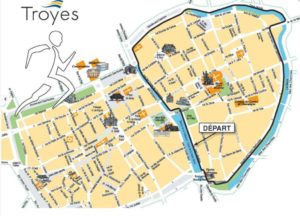
Often overlooked by visitors either planning a trip around the Champagne region, or further south to Dijon and the Burgundy district, Troyes is one of the best places to get a sense of what Europe looked like back when Molière was penning his best plays and the Three Musketeers were swashbuckling their way through France. To add to its attraction, Troyes is only 1 ½ hrs by train from Paris Gare d’Est or less than 2 hrs. by car.
Given its historic relationship with the champagne district, the centre of Troyes is appropriately shaped like the cork of a champagne bottle, with a rectangular outline defined by avenues of trees and a rounded top encircled by the Seine.
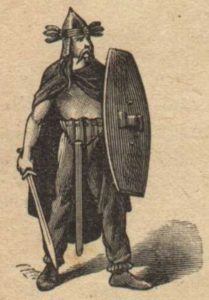
In prehistoric times, the area was settled by a local tribe called the Tricasses and the Romans named it Augustobona Tricassium. The Romans appreciated its strategic location, being the central point between several Roman routes, including the Agrippa Way, connecting Milan to Boulogne-sur-Mer. Other Roman routes from Troyes led to Poitiers, Autun and Orléans. Of the Gallo-Roman town of the early Empire, some scattered remains have been found, but no public monuments, other than traces of an aqueduct. The Battle of Troyes, also known as the Battle of the Catalaunian Plains, was fought nearby in 451AD between the combined forces of the Roman general Flavius Aetius and the Visigothic king Theodoric 1, against Attila the Hun.
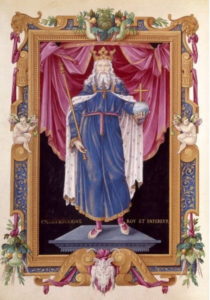
Troyes has long been a prosperous town. It enjoyed Roman religious support as well as trade in ancient times, became an administrative centre in Charlemagne’s empire, and its location on a trade route between Italy and the cities of Flanders in the Middle Ages was a major factor in its increasing prosperity. This was the age when the town, as capital of the Champagne District, and under the protection given to merchants by the Counts of Champagne, hosted two vital annual fairs, in July and November, relating to the cloth trade. Each of these lasted for three months and brought craftsmen and merchants from all over Europe which increased the coffers of the local merchants and the town’s leading families.
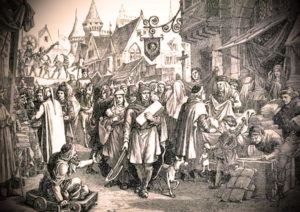
The Foires de Champagne (fairs) were one of the earliest manifestations of a linked European economy in the High Middle Ages. Caravans of pack mules crossed the Alps carrying merchandise from the cloth-merchants’ guilds of Florence, Siena and Genoa, while other merchants travelled from Flanders and elsewhere across Europe.
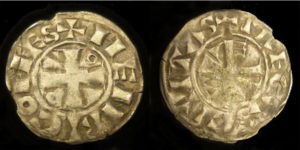
The Foire de St Remi, or the “cold fair” of Troyes was held on the day following All Saints’ Day (02 November). It began with eight days for the merchants to set up, followed by the days allotted for the cloth fair, then the days of the leather fair, and lastly, the days for the sale of spices and other commodities sold by weight (avoirdupois). In the last four day period of the fairs, accounts were settled. During these years Troyes was also the namesake of ‘troy’ weight for gold as a standard measurement, which was developed here. The long-distance trade, together with the more extensive use of coinage and credit, were the main drivers of the medieval economy of Troyes.
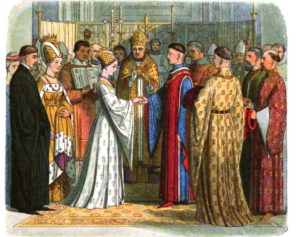
On 21 May 1420, the Treaty of Troyes was signed in the city, which at that time was still under the control of the Burgundians. Under this treaty, Henry V of England was betrothed to Catherine, the daughter of the French king Charles VI, which also meant that Henry was to succeed Charles, to the detriment of the Dauphin. However, in 1429 Charles VII and Joan of Arc, after the Siege of Troyes, recovered the city for France.
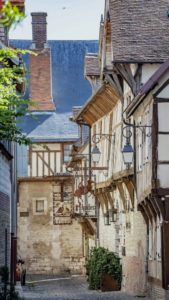
A fire in 1524 destroyed much of the medieval city, which by this time was a centre for hosiery as well as cloth making. Fortunately, the city had numerous canals separating it into ‘quartiers’. The upper quarter was originally the centre of the bourgeois elite—the wealthiest merchant families—who effectively ran the city from the 14th to the 16th centuries.
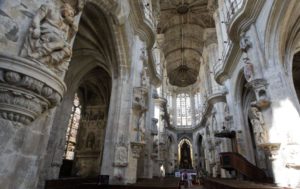
This sector was centred round the church of St Pantaleon, the meeting place for the Foires de Champagne, which played a major part in revitalising the city’s economy, being the most important fairs for textiles, leather, fur and spices in Europe. Today, this district has magnificent buildings, some of which have been transformed into hotels.
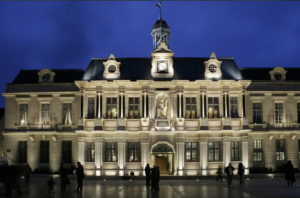
At the end of the Middle Ages, the centre of power in Troyes moved westward, and the City Council was set up in the new Hotel de Ville (Town Hall) built in the early 17th century. Precious metal shops were created in what was to become the rue de la Monnaie, attracting silversmiths from other districts.
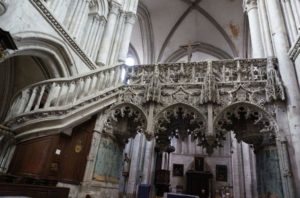
A number of the grandest families lived around the church of Sainte-Madeleine, trading in fine arts, clothing, tanneries and especially finance. They built themselves superb town houses, several of which are still standing. Many of these buildings were rebuilt in stone following the 1524 fire. The area is now known is the Madeleine District.
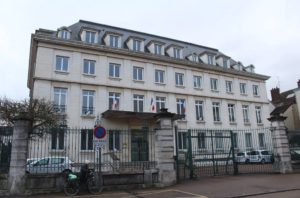
In the nearby rue du General de Gaulle, nearly all the houses had a cellar where cotton weavers worked in the damp atmosphere before transferring to the power looms introduced in the 19th century. Along this street, the Palais de Justice was built on the site of a former convent.
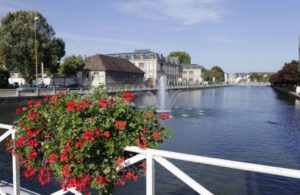
The Canal District originated from a marshy area that provided a freely available water resource. Early settlers built a fortified town by the end of the 12th century, which included four watermills to supply water for local industry. Drinking water was provided by the Moline canal, a tributary of the Seine, as well as being an additional water supply for cotton mills, shops, tanneries and clothing workshops.
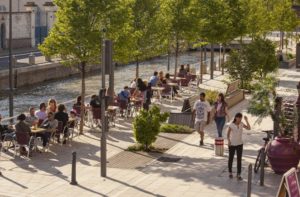
In 1805, Napoleon had the Haute-Seine canal and the Prefecture basin built to link the Bourgogne canal to Paris in order to promote the transport of goods. Running water was installed in Troyes in 1850, and many of the town’s 70 public wells were closed. Today, Troyes is rebuilding its wells based on ancient plans, so that visitors can stroll through the bouchon and see the carefully sculpted parapets and delicate ironwork.
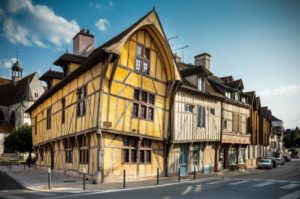
The area known as the Cité District is located in the fortified part of the Gallo-Roman town, the ramparts of which were built at the end of the 3rd century AD to protect the citizens from German invasions. The stone walls enclosed the Christian centre as well as the château built for the first Counts of Champagne (now the Place de la Tour).
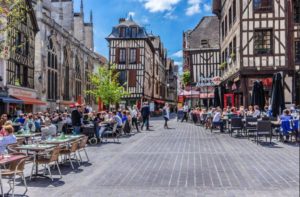
During the 12th and 13th centuries the Counts encouraged expansion outside the walls, leading to its shape developing like a champagne cork (le bouchon de Champagne)—very appropriate, given that Troyes was the capital of the Champagne District. At this time, there were 12 churches and 2 convents in the city and the social, commercial and cultural life developed rapidly in this neighbourhood. Many of these buildings have survived and been preserved, including the Cathedral, and consequently this whole area is particularly interesting for its architecture.
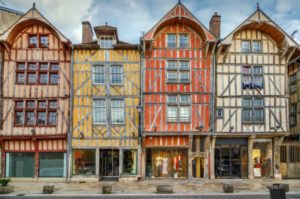
The Les Halles District, located along the main road to Paris, is called the corps du bouchon (the body of the cork), and is the area where the craftsmen and merchants lived. During the Middle Ages, with the development of the Champagne Fairs, the area became famous for its artisan workshops, including glassworkers and timber joiners. Today, the area continues to produce items of high quality, and is the commercial heart of the city. This is one of the best part of Troyes for the visitor to explore, with narrow, medieval alleys and interesting 18th and 19th century buildings now housing shops, department stores and banks.

The Saint-Jean District, also known as the Champagne Fair district, is where traders congregated to do business. Famous throughout Europe, the fairs would attract wine merchants, cloth merchants, butchers, apothecaries, herbalists and bakers, all plying their trade amongst the local clothiers and shoemakers, while the squares would be alive with entertainers such as jugglers and musicians. The timber houses in this District have recently been undergoing a refurbishment and restoration program, providing a fascinating insight into the town’s medieval past, with the buildings’ beautiful carved façades and broad shopping streets—great for strolling and admiring.
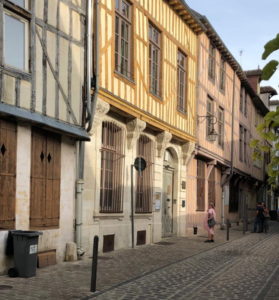
The old Jewish Quarter, or Broce-aux-Juifs, stretched along the Quaie de Comtes de Champagne. A large Jewish community settled in Troyes from the Middle Ages, and a Talmudic school was founded in 1070 by a Rabbi known as Rachi, which is commemorated by the Rachi European University Institute, opposite the synagogue. This Quarter was known for its fine silversmith shops and money changers. The mint was built in the Hôtel des Monnaies, which is located near the church of Saint-Jean, and is a very interesting place to wander to learn about the history of the Jewish population of Troyes.
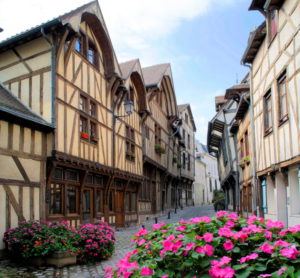
In the 10th century, the Gallo-Roman city was extended and the Bourg-l’Eveque neighbourhood developed, and became known as the Saint-Nizier District. There are fine examples of beautiful 16th century half-timbered, multi-coloured houses which have been restored and are among the oldest in Troyes. Along the riverbanks of the Seine are several historic mansions which are open to the public, and well worth a visit.
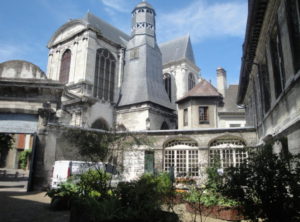
One of the must-sees in Troyes is the Musée de Vauluisant, which is home to the Musée d’Art Champenois (Regional Art Museum) as well as the Musée de la Bonneterie (Textile-Hosiery Museum). The latter is fascinating, particularly given that Troyes was the hosiery capital of France from the early 1700s right up to the 1960s. The building is very distinctive, with its twin turreted towers, so you can’t miss it.
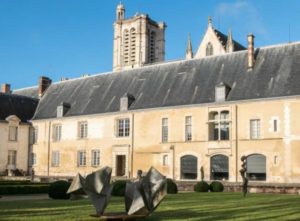
Housed in the former Bishop’s Palace, Troyes’ Museum of Modern Art features the impressive collection of hosiery manufacturers Pierre and Denise Levy. Comprising works from the 19th and 20th centuries, there are works from the likes of Bonnard, Gauguin, Seurat, Courbet, Vuillard, Balthus, Dufy, Renault and Matisse.
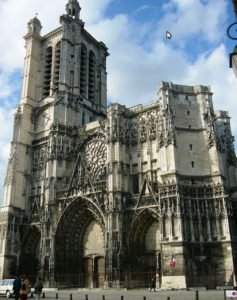
Not to be missed is the Cathédrale St-Pierre et St-Paul located in the heart of Troyes. Built in the Flamboyant Gothic style, built between 1220 and roughly 1400, it’s regarded as one of the most beautiful churches in Europe. Henry V of England married Catherine de Valois in the cathedral in 1420.
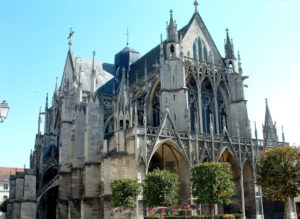
There are two other churches that should be part of any Troyes itinerary. The first is the majestic Église Sainte Madeleine, dating back to 1120, and rebuilt in 1200. It’s the old oldest church in town, and one of its best attractions. The other is the Basilique Saint Urbain.
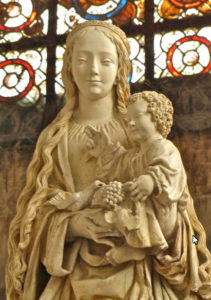
Known for its stunning stained glass and fine sculptures, construction of this Gothic jewel commenced in 1261 by Pope Urban IV, a native of Troyes. Don’t miss the Renaissance-era statue of the Vierge aux Raisins (Virgin with Grapes), which depicts the Virgin Mary holding the child Jesus, who has a bunch of grapes in His hand.
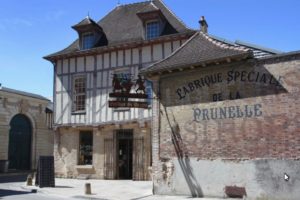
In the historic centre of the Bouchon de Champagne, just a few minutes’ walk from the Église Sainte-Madeleine and the Tourist Bureau is perhaps the most iconic street in Troyes, still looking much as it would have back in the 13th century.
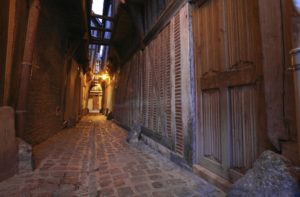
You’ll come across La Ruelle des Chats (Cats’ Alley), originally called rue Maillard until the 15th century. It was so named because the roofs and lofts are so close together that it was said that cats could jump across from one attic across the street to another. When you see how the houses in this narrow street lean closer together the higher up they go—rather like friends whispering secrets—it’s easy to believe the cats story!
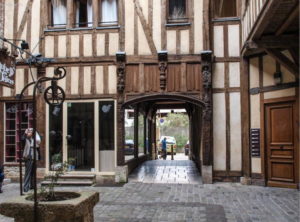
The Ruelle des Chats leads via a short, arched passageway to the very pretty cour du Mortier d’Or (golden mortar courtyard), from which you can see the rear of the half-timbered houses with their beautiful galleries and the decorative carved timberwork.
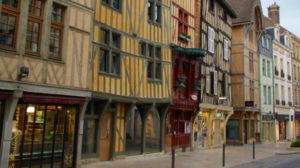
At the beginning of this story, I mentioned that Troyes was a great destination for those who love fashion. Given its historic relationship to the textile and garment manufacturing industries, it seems very appropriate that the town is a mecca for shopping, with good shops in the town itself, but is most especially known for its nearby four outlet centres and 200 outlet shops.
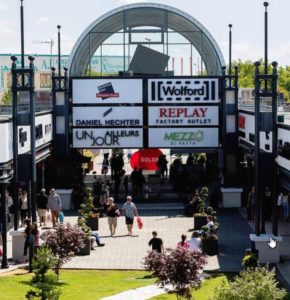
All year round, great deals are available on major ready-to-wear brands. One is located 5kms in the north-east of Troyes in Pont-Sainte-Marie, and the other is at Saint-Julien-les-Villas, in the south-east. In Pont Sainte-Marie there are three outlet centres built next to each other. They are Marques City, McArthur Glen Troyes and Village de Marques.
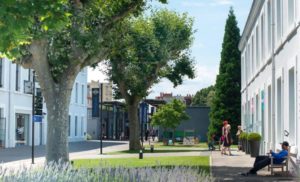
Marques City is spread over 15,000 sq.m., and its outlet stores are set up in several independent buildings selling around 100 brands, mostly trendy sports and prestige clothing, shoes and accessories. McArthur Glen Troyes offers a different concept as it’s built in the shape of an open-air village with mock half-timbered houses echoing the buildings in town. This outlet centre is spread over 30,000 sq.m., with around 100 shops, each dedicated to one specific brand, focussing on luxury and premium fashion brands with a wide range of international brands such as Lacoste, Nike, Armani, Polo Ralph Lauren, Hugo Boss, Reebok, Michael Kors, and Calvin Klein as well as French fashion labels such as Café Coton, Caroll, Claudie Pierlot Christine Laure, Descamps, Bayard, De Fursac, Aigle, and Catimini childrenswear, to name just a few.
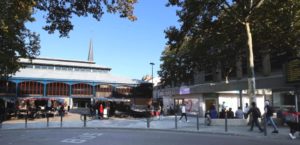
If you’re not driving, there are regular buses from Troyes. Lines 1 and 12 from Les Halles to the bus stop Magasins. From Troyes train station there is a frequent bus service to McArthurGlen Designer Outlet stores.
Saint-Julien-les-Villas, located 3 km from Troyes, is set up in an authentic 2 level brick textile factory rehabilitated as a shopping centre. This outlet offers men’s, women’s and childrenswear as well as a variety of household items. Aside from driving there, the Tourist Bureau in Troyes at 16 rue Aristide Briand, will be able to advise if there are buses from town to take you there.
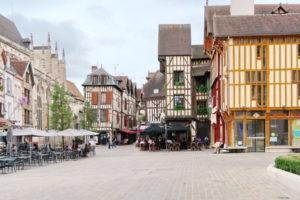
Another good reason to visit the Tourist Bureau is to purchase the ‘PassTroyes’, a must-have passport that for around 12€ offers special prices in designer outlets, guided tour and museum entrance.
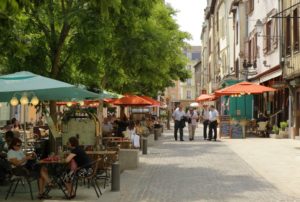
Troyes is the perfect blend of fascinating history and beautiful architecture, where you can also satisfy your urge for some great value retail therapy. As well, during the summer months, garden enthusiasts are also in for a treat: not only is the town listed as a 3 star Ville Fleurie, but several individual gardens are also open to the public and merit exploring, including the Jardin des Innocents, the garden of medicinal plants, and a garden of aromatic plants. Ask at the Tourist Bureau for specific information.
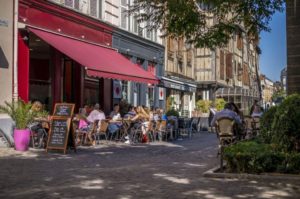
After all this activity, take time to relax in one of Troyes’ delightful cafes housed in a charming historic maison à pans de bois (half-timbered house), and soak up the atmosphere while enjoying a glass of champagne, excellent local wine or the famous rosé des Riceys, so rare it’s almost impossible to find anywhere outside of the Champagne District. After a couple of days exploring this charming, old capital of the Champagne, you might wonder why you’ve never heard of it let alone been here before!
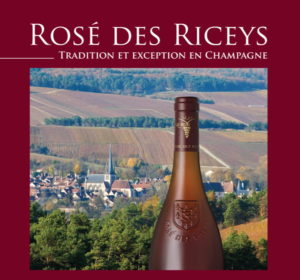

Bill Collins
Thanks Cheryl
We are inspired to make Troyes part of our next visit to France.
Your descriptive commentary is outstanding.
Trish and Bill
Cheryl Brooks
Hi Trish and Bill,
How lovely to hear from you, and many thanks for your kind words. You’re right about Troyes: it’s a must-visit, especially as it’s so accessible, and also for those like yourselves that know France well and want to see something that’s a bit off the beaten tourist track (although it’s very popular with the French). Won’t it be wonderful to be able to plan some trips, hopefully soon?!
Thanks again for your comments–always much appreciated. Best regards, Cheryl
Rosemary Deans
How interesting and inviting to read this article. Several years ago, my husband and I took the train from Paris to Troyes and then rented a car to travel to Essoyes. We were on a quest to find the military grave of my husband’s uncle, a Canadian Air Force pilot whose plane was shot down near Essoyes where he is buried. This was a day trip from Paris and we were so disappointed that we did not have time to explore the fascinating town of Troyes. We plan to make a point of spending a day or two in Troyes on our next visit to France in the spring of 2023. Thank you for this very enticing and informative description.
Rosemary
Cheryl Brooks
Hi Rosemary,
What an interesting mission you had on your pursuit of the military grave of your husband’s uncle. I know that many people have had that object in mind when travelling to specific destinations, particularly in France. My mother’s uncle (the only boy in a family of 5 daughters) was killed at Villers Bretonneux in WW1, and she would have liked to have tracked down his name on the huge memorial to those who perished during that battle, but never managed to do so.
Regarding Troyes: yes, do put it on your list to visit. It’s a very rewarding town and easy to get to from Paris from Gare d’Est, as I mentioned in my last blog. We’ve been there a couple of times over the years, and each time it’s lovely to see how much more restoration and adaptive re-use has gone on in the town since our previous visit. There’s enough to keep you busy, without rushing it, for just a day trip, if that’s all you can manage, although an overnight, if en-route further afield, is great. I always think it’s odd that it was once the capital of the Champagne district, since it’s not really where we think of with that region. More like the very top of Burgundy. A most interesting history.